TECTONIC REGIONS OF NORTH AMERICA
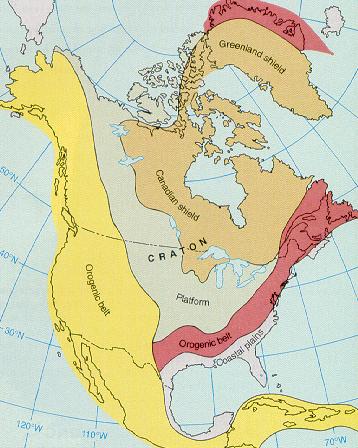
The distribution of tectonic activity around continents (including
North America) usually provides a clear contrast between continental
interiors and margins; and between leading margins (converging or
active) and passive margins (diverging or trailing). This division
provides us with distinct large-scale structural regions:
a) Shields: old, exposed precambrian metamorphic and
igneous rocks at the "core" of continents. The metamorphic rocks are
the "roots" of ancient mountain belts, long since eroded away.
b) Platforms: adjacent to shields, similar rocks, but covered by newer
sedimentary rocks (shield + platform = craton).
c) Orogenic belts - the currently or formerly active edge of continents,
severely deformed due to earth
movements (orogenic
= "mountain-building").
d) Passive margins - the trailing edge of continents; little or no tectonic
activity.
Craton:
The North American craton is exposed mainly in the Canadian Shield. Cratonic
rocks are also called "basement rocks" because they underlie other
more recent rocks in Platform regions. The craton tends to be very stable, but
has undergone broad warping
in the past - especially in platform areas, creating
basins, domes and tilted strata.
Platforms
Platforms are parts of the craton which are covered by relatively undeformed
layers of sedimentary rock, formed when seas occupied these areas (due to
tilting/sinking of the craton or rise in sea level). A large part of the
interior of
North America consists of platform areas. Structure within
the platform rocks is usually quite subdued:
however, many parts of platforms
are not completely flat; instead broad
warping of the underlying craton has
produced gently tilted beds (< 5o), domes
(e.g. the Black Hills of Dakota; Ozark Mountains of Missouri) and
basins (e.g. Michigan Basin, Permian Basin).
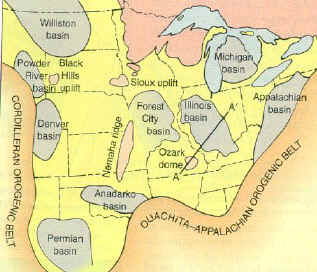
An exception to the
generally subdued structure of platforms, resulting from plate movements, is
intracratonic rifting which forms rift valleys, seas and aulacogens in platform
regions.
A relatively new idea in
plate tectonics suggests that rifting may actually be initiated by hot spots
which cause the continental crust to dome up and split into a triple rift.
Commonly, one of the rift
arms fails, while the other two become active and contribute to an opening
linear ocean basin. So the convection cell that drives sea-floor spreading may
actually be a line of "hot spots".
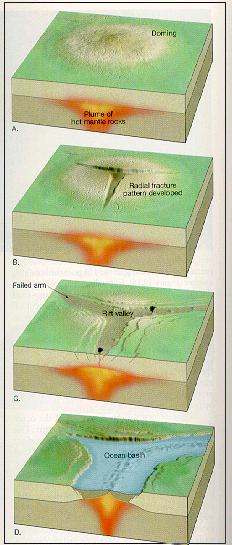
The rift valley forms a
large linear trough, bounded by fault scarps and floored by volcanic rocks (e.g.
the East African Rift Valley). If the valley extends below sea level, it becomes
the site of sedimentation.
The failed arm, represented by a deep linear trough into the adjacent continent,
may become a natural location for a major river valley within platform areas -
probable examples include the Mississippi and the Amazon.
It is also possible for a failed arm of a rift to become "squeezed
shut" by later plate movements - forming an aulacogen. The Arbuckle
Mountains lie on the northeastern margin of the southern Oklahoma aulacogen.
Closure of the aulacogen resulted in severe folding and faulting of marine
sedimentary rocks which had accumulated in the trough - one of the few places
that platform strata are so deformed.
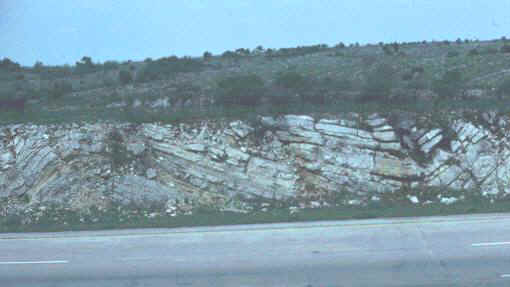
FOLDED ROCKS IN THE ARBUCKLES
Orogenic Belts
In the case of North America there are two major orogenic belts - the older
Appalachian chain in the east, and the much younger Rockies in the west. Both
were formed by plate convergence and have similar structural features. Both
areas underwent uplift, metamorphism, volcanism, folding, thrust faulting and
later erosion; some crustal extension was also experienced in the west.
The present-day relief of
these mountains is a result of erosion - the Appalachians being much older are
more subdued and lower and consist mainly of eroded folds.
The western Cordillera
has a number of other features related to orogenesis:
Erosion has exposed the granitic batholiths emplaced during orogenesis, forming
the Sierra Nevada Mountains.
Another part of the crust in the west underwent stretching during the orogeny -
forming the Basin and Range Province. These ridges and valleys are formed by
normal faulting caused by crustal stretching.
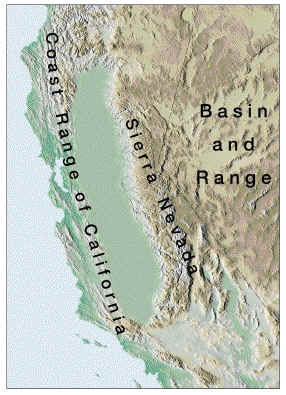
Another large region in
the west experienced uplift, but with little deformation, forming the large
Colorado plateau - rivers cut down through the uplifted strata forming many
canyons, including the Grand Canyon.
The Atlantic and Gulf
Coast margins of the U.S. are PASSIVE MARGINS, characterized by low-lying flat
coastal plains extending below sea-level into a wide continental shelf.
Back
to review index.
Back to
Geomorphology Home Page.




